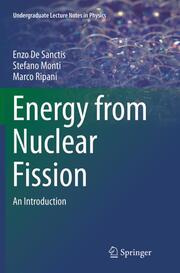Detailansicht
Energy from Nuclear Fission
An Introduction, Undergraduate Lecture Notes in Physics
ISBN/EAN: 9783319808598
Umbreit-Nr.: 5458352
Sprache:
Englisch
Umfang: xv, 278 S., 55 s/w Illustr., 278 p. 55 illus.
Format in cm:
Einband:
kartoniertes Buch
Erschienen am 31.05.2018
Auflage: 1/2016
- Zusatztext
- This book provides an overview on nuclear physics and energy production from nuclear fission. It serves as a readable and reliable source of information for anyone who wants to have a well-balanced opinion about exploitation of nuclear fission in power plants. The text is divided into two parts; the first covers the basics of nuclear forces and properties of nuclei, nuclear collisions, nuclear stability, radioactivity, and provides a detailed discussion of nuclear fission and relevant topics in its application to energy production. The second part covers the basic technical aspects of nuclear fission reactors, nuclear fuel cycle and resources, safety, safeguards, and radioactive waste management. The book also contains a discussion of the biological effects of nuclear radiation and of radiation protection, and a summary of the ten most relevant nuclear accidents. The book is suitable for undergraduates in physics, nuclear engineering and other science subjects. However, the mathematics is kept at a level that can be easily followed by wider circles of readers. The addition of solved problems, strategically placed throughout the text, and the collections of problems at the end of the chapters allow readers to appreciate the quantitative aspects of various phenomena and processes. Many illustrations and graphs effectively supplement the text and help visualising specific points.
- Kurztext
- This book provides an overview on nuclear physics and energy production from nuclear fission. It serves as a readable and reliable source of information for anyone who wants to have a well-balanced opinion about exploitation of nuclear fission in power plants.The text is divided into two parts; the first covers the basics of nuclear forces and properties of nuclei, nuclear collisions, nuclear stability, radioactivity, and provides a detailed discussion of nuclear fission and relevant topics in its application to energy production. The second part covers the basic technical aspects of nuclear fission reactors, nuclear fuel cycle and resources, safety, safeguards, and radioactive waste management. The book also contains a discussion of the biological effects of nuclear radiation and of radiation protection, and a summary of the ten most relevant nuclear accidents.The book is suitable for undergraduates in physics, nuclear engineering and other science subjects. However, the mathematics is kept at a level that can be easily followed by wider circles of readers. The addition of solved problems, strategically placed throughout the text, and the collections of problems at the end of the chapters allow readers to appreciate the quantitative aspects of various phenomena and processes. Many illustrations and graphs effectively supplement the text and help visualising specific points.
- Autorenportrait
- Enzo De Sanctis is Director of Research Emeritus at the Frascati Laboratory of INFN, Member of the Energy Group of the European Physical Society, and Associate-Editor of the Journals EPJ-Plus, Il Nuovo Cimento and Il Nuovo Saggiatore. He served in a number of national and international scientific committees, among which: EPJ-A (Editor in Chief), Italian Physical Society (Vice President and Councilor); INFN Board of Directors; OECD Megascience Forum; Editorial Board of Physical Review C; CERN-NuPECC Working Group for the ELFE project (Director); Programme Advisory Committee of JLab; Council of Frascati Laboratory, INFN National Committee for Nuclear Physics. He has been working on experimental nuclear and hadron physics for more than 45 years, leading research projects at the accelerators of Frascati, Saclay, Bonn, DESY (Hamburg) and Jlab (Newport News, VA, USA). He has published more than 300 papers on refereed, international journals. He is also co-author of six physics books for university students and he has co-edited ten proceedings of Conferences/Workshops. Stefano Monti is the Scientific Secretary of the IAEA's Technical Working Group on Fast Reactors (TWG-FR) and member of the Publication Committee. He received his degree in Nuclear Engineering at University of Bologna in 1982. He. For over 30 years he has been working on several national and international projects and programmes on advanced nuclear systems, leading a number of international research groups. As Director of Research at ENEA, he was Head of Nuclear Fission Division, President of SIET, and scientific coordinator of the R&D programme on nuclear fission. He served in a number of national and international nuclear committees, among which: the INFN Board of Directors, the Steering Committee and the NDC Committee of the OECD-NEA, the IAEA TWG-FR, the Sustainable Nuclear Energy Technology Platform, the European Sustainable Nuclear Industrial Initiative and the European Energy Research Alliance (EERA) on Nuclear Materials. Marco Ripani is senior staff scientist at the Genova unit of INFN. He has been working on experimental nuclear and hadron physics for more than 20 years, participating to research projects at the accelerators of Frascati, NIKHEF, ESRF (Grenoble, France) and leading research projects at JLab (Newport News, VA, USA). He is currently leading the national INFN project on energy-related topics, within which he carries on research on subcritical reactors and neutron detectors. He served in a number of national and international scientific committees, among which the Group of Experts for the Art. 37 of the Euratom Treaty on the disposal of radioactive waste. He has been referee for grant applications to several research funding agencies worldwide. He has published more than 200 papers on refereed international journals.
